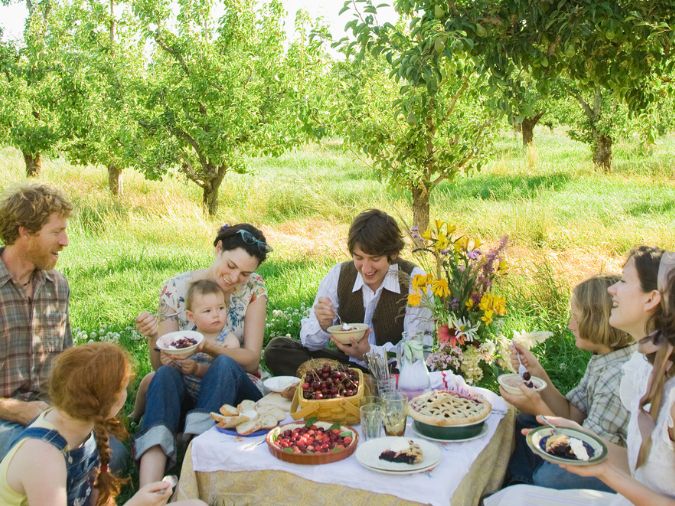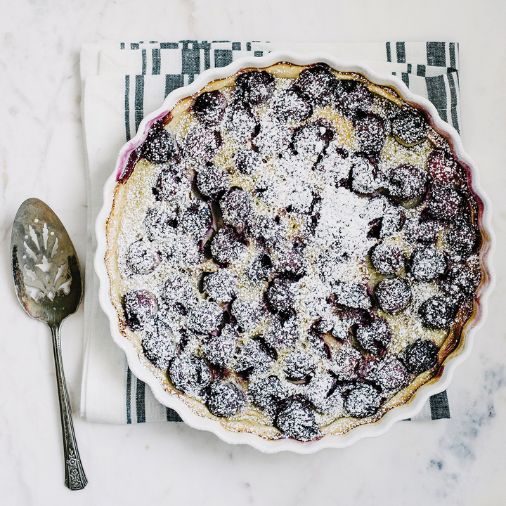Nothing captures the flavour of the season like stone fruits. This clafoutis recipe will help you make the most of them while you can.

Is there a sweeter taste of summer than a peach plucked straight from the tree, its velvety skin warmed by the sun, its juices like honey? Well, maybe a handful of cherries or a perfect plum, apricot or nectarine, each so headily fragrant and juicy.
Summer is the season of stone fruits, the most tempting, tantalizing and fleeting tastes of the season.
But these are not tastes we’ve had much opportunity to enjoy these past few years, at least not from B.C. orchards. Stone fruits, also known as drupes, tend to have a soft, juicy, delicate flesh around a hard pit or stone that contains a seed. B.C. is famous for its stone fruits, especially peaches and cherries from the Okanagan Valley. Last year, though, some 90 per cent of the entire crop of Okanagan stone fruit was wiped out in the same deep freeze that devastated the vineyards. That January cold snap, when temperatures plummeted to –27°C after an unusually long, mild fall, killed off buds that had only just begun to recover from the 2021 heat dome and the harsh winter of 2022-2023.
But this year promises to be different. Thankfully, most of the trees survived the winter event even if their buds didn’t, and farmers have been cautiously optimistic about the 2025 harvest. That means B.C. stone fruits should be trickling into markets, well, right about now.
(Although stone fruits will grow in sheltered areas on Vancouver Island, and you may even have some in your own yard, the climate is too cool for them to be a serious commercial crop here. There’s a reason why the hot, sun-drenched Okanagan Valley is the land of peaches and beaches.)
The apricots are typically the first to flower; in early April, their blossoms are like fluffy white clouds against the dull, dusty backdrop of a landscape still emerging from its winter slumber. By the end of the month, the cherries, peaches and plums have caught up, the valley a bower of pink and white blooms fragrant with the promise of delicious things to come.
The first to ripen, though, are the cherries, and in a good year we will have cherries from mid-June to late July. They’re followed by apricots in early July to early August. Peaches come next, ripening from late July to early September, plums from early August to late September and nectarines from mid-August to early September.
It’s not a long season, so it’s best to make the most of it while it lasts.

Plum or Cherry Clafoutis
This classic French fruit dessert is not quite a custard, not quite a pancake, a little of both and thoroughly delicious.
Serves 6 to 8
- ¾ cup granulated sugar, divided, plus extra for baking dish and sprinkling
- 2 cups pitted and halved cherries or pitted and quartered Italian prune plums
- 1 Tbsp unsalted butter, at room temperature
- ½ cup all-purpose flour (alternatively, cup
- all-purpose flour plus ¼ cup almond or hazelnut flour)
- 1 tsp kosher salt
- 3 large eggs
- 1 cup whole milk
- 1 tsp vanilla paste or extract
- 1 tsp finely grated lemon zest
- Optional: Powdered sugar for serving
Place rack in centre of oven; preheat oven to 350°F.
Toss ¼ cup sugar with the prepared fruit and set aside.
Butter and sugar (about 1 tablespoon of each) the bottom and sides of a 9- or 10-inch cast-iron skillet or ceramic baking dish. Spread the sugared fruit evenly in the prepared pan, then transfer to a baking sheet and set aside.
Prepare the batter: In a medium-sized bowl, whisk together the remaining ½ cup sugar with the all-purpose flour, almond flour (if using) and salt.
In a separate, large bowl, whisk together the eggs, milk, vanilla and lemon zest until well combined, about 1 minute.
Add the flour mixture to the egg mixture and whisk very well until everything is fully incorporated.
Pour the batter on top of the fruit. If you like, sprinkle the top with about a tablespoon of sugar to create a sweet, golden crust.
Bake until the clafoutis is puffy, browned and set, 55 to 65 minutes.
Let cool in the pan for at least an hour before serving (it will sink a bit as it cools). If you like, sprinkle it with a little icing sugar just before serving.
Clafoutis can be served warm, cold or at room temperature; it will keep in the refrigerator for up to 3 days.




